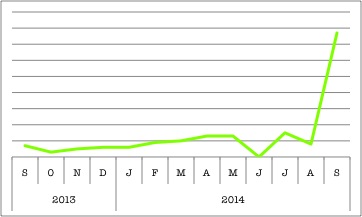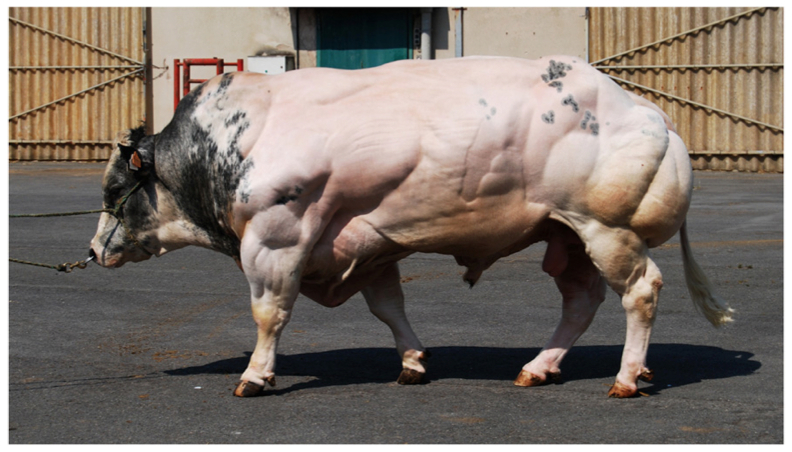The Hulk had gamma radiation, Peter Parker had a radioactive spider, and the Spartans had the official 300 Workout (and CGI). What “double-muscled” mice have is a mutation in myostatin…
Expressed primarily in skeletal muscle, myostatin is a secreted protein that modulates the proliferation and differentiation of muscle precursor cells, ultimately acting as a negative regulator of muscle growth.1 Mice without myostatin have uncontrolled muscle growth, which results in 2-3x more muscle mass!2 Since myostatin also regulates adipose tissue and metabolism, these myostatin knockout mice also have reduced body fat, and are resistant to fat accumulation.3
![No, he isn’t just well-fed … this doubled-muscled mouse (right) is much larger than wildtype (left) because of a myostatin mutation! [Image: Lee Se-Jin.]](http://sulab.org/wp-content/uploads/2014/10/myostatinmouse.jpg)
No, he isn’t just well-fed … this doubled-muscled mouse (right) is much larger than wildtype (left) because of a myostatin mutation! [Image: Lee Se-Jin.]
In the case of dogs, a mutation in myostatin not only enhances muscle growth, but also significantly affects racing performance.4 Whippets (called “bully whippets” when they have this muscular phenotype) are significantly faster if they’re deficient in myostatin.5 Similarly, racing performance in horses has also been linked to a specific gene variant of myostatin.6

Whippets that are heterozygous for the myostatin mutation are more muscular than wildtype, and homozygous super-whippets are even more heavily muscled! [Image: Mosher et al. (2007)]
In the agricultural industry, cattle with myostatin mutations have been of enormous interest, given that these animals convert food more efficiently into muscle.7 However, this increased meat yield is offset by other (expensive) problems; these Belgian Blue and Piedmontese breeds might have less bone, less fat, and 20% more muscle than regular cattle, but they also have decreased fertility rates and fewer viable calves.8
There’s even been a case of myostatin mutation in a human child, causing extreme muscle growth. At birth, this newborn boy already had “protruding muscles” in the thighs and upper arms, and by 4½ years, could suspend two 3-kg dumbbells horizontally, with his arms extended!9 While this child carries a homozygous myostatin mutation, his mother is heterozygous for the same mutation—and she’s a former pro athlete.10 Unfortunately, loss of myostatin could have negative side-effects (including decreased muscle oxidative capacity),11 so doctors will continue to monitor the child for potential health risks.
Recent results from the first clinical trial on myostatin inhibitors might be responsible for Myostatin’s rise in BioGPS popularity!
Despite what some shady internet ads claim, we still know very little about how myostatin inhibitors affect the body. Bodybuilders might see this as a recipe for instant muscles (or perhaps, the start of a really boring superhero origin story?), but researchers are investigating this as a possible therapy for muscle loss. Muscle wasting can occur during cancer, or in rarer diseases like Duchenne muscular dystrophy, and nearly everyone will experience age-related muscle loss; myostatin might be a good clinical target for any of these conditions. Indeed, the first clinical trial using myostatin inhibitors in humans was recently completed! As a Phase I clinical trial, this study is limited by its short duration and small sample size, but even so, has some promising results. When treated with myostatin inhibitors, subjects experienced a small (but significant) increase in lean body mass and decrease in fat mass—in just 29 days!12 Of course, this has to be repeated at a larger scale, and is only in early stages now, but this progress is encouraging. The potential for treating such a variety of conditions and patients is already, quite heroic.
REFERENCES:
- Grossmann M. (2014) Myostatin inhibition: a new treatment for androgen deprivation-induced sarcopenia? J Clin Endocrinol Metab 99(10):3625-8. [↩]
- Mosher DS, Quignon P, Bustamante CD, Sutter NB, Mellersh CS, Parker HG, Ostrander EA. (2007) A mutation in the myostatin gene increases muscle mass and enhances racing performance in heterozygote dogs. PLoS Genet 3(5):e79 [↩]
- Grossmann M. (2014) Myostatin inhibition: a new treatment for androgen deprivation-induced sarcopenia? J Clin Endocrinol Metab 99(10):3625-8. [↩]
- Mosher DS, Quignon P, Bustamante CD, Sutter NB, Mellersh CS, Parker HG, Ostrander EA. (2007) A mutation in the myostatin gene increases muscle mass and enhances racing performance in heterozygote dogs. PLoS Genet 3(5):e79 [↩]
- Mosher DS, Quignon P, Bustamante CD, Sutter NB, Mellersh CS, Parker HG, Ostrander EA. (2007) A mutation in the myostatin gene increases muscle mass and enhances racing performance in heterozygote dogs. PLoS Genet 3(5):e79 [↩]
- Dall’Olio S, Scotti E, Fontanesi L, Tassinari M. (2014) Analysis of the 227 bp short interspersed nuclear element (SINE) insertion of the promoter of the myostatin (MSTN) gene in different horse breeds. Vet Ital 50(3):193-7. [↩]
- Kambadur R, Sharma M, Smith TP, Bass JJ. (1997) Mutations in myostatin (GDF8) in double-muscled Belgian Blue and Piedmontese cattle. Genome Res 7(9):910-6. [↩]
- Kambadur R, Sharma M, Smith TP, Bass JJ. (1997) Mutations in myostatin (GDF8) in double-muscled Belgian Blue and Piedmontese cattle. Genome Res 7(9):910-6. [↩]
- Schuelke M, Wagner KR, Stolz LE, Hübner C, Riebel T, Kömen W, Braun T, Tobin JF, Lee SJ. (2004) Myostatin mutation associated with gross muscle hypertrophy in a child. N Engl J Med 350(26):2682-8. [↩]
- Schuelke M, Wagner KR, Stolz LE, Hübner C, Riebel T, Kömen W, Braun T, Tobin JF, Lee SJ. (2004) Myostatin mutation associated with gross muscle hypertrophy in a child. N Engl J Med 350(26):2682-8. [↩]
- Kainulainen H, Papaioannou KG, Silvennoinen M, Autio R, Saarela J, Oliveira BM, Nyqvist M, Pasternack A, ‘t Hoen PA, Kujala UM, Ritvos O, Hulmi JJ. (2014) Myostatin/activin blocking combined with exercise reconditions skeletal muscle expression profile of mdx mice. Mol Cell Endocrinol S0303-7207(14)00311-6. [↩]
- Grossmann M. (2014) Myostatin inhibition: a new treatment for androgen deprivation-induced sarcopenia? J Clin Endocrinol Metab 99(10):3625-8. [↩]


I have been really excited about this for quite some time and am delighted at the news that the first small, sanctioned, human trial ended in success.
The only thing that keeps crossing my mind, is how this will affect the heart, seeing that it is nothing more than a muscle.
If there are ever any further trials … I would really like to know about them so as to be able to participate.
Induced deletion of myostatin in the adult heart leads to cardiac hypertrophy and failure
Could a problem with myostatin be responsible for a recently emerged disease in commercial broiler chickens called ‘wooden breast’? Breast muscles in these birds enlarge to the point they apparently outgrow the ability to maintain the myocytes, which subsequently undergo degeneration.